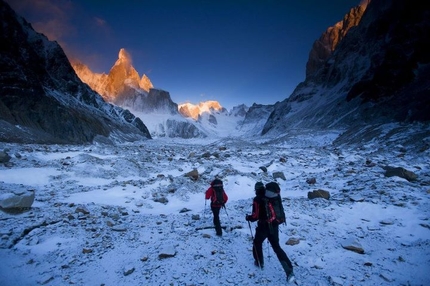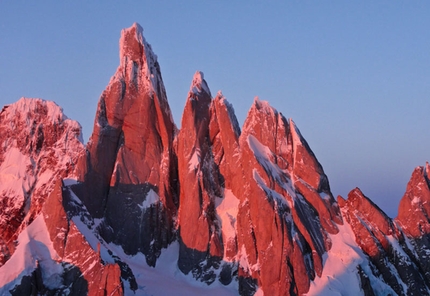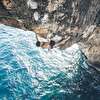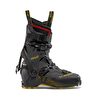David Lama - interview after the Compressor Route on Cerro Torre

 1 / 9
1 / 9 Rich/Else – Red Bull Content Pool
Rich/Else – Red Bull Content Pool
January has been a rather particular month in Patagonia, above all because of two events which took place on Cerro Torre's famous Compressor Route. The first is the ascent (with the use of 5 bolts and one section of A2 aid) of the Americans Hayden Kennedy and Jason Kruk and the successive bolt chopping of a large part of the route established by Cesare Maestri – an undertaking which shook and stirred the mountaineering world like few others before. The second event, which took place shortly afterwards, was the coveted first free ascent of the Maestri route by Austrian David Lama and his friend Peter Ortner. Immediately after the ascent Lama published some first details on Facebook while last week's second update provided further information, such as the gear they took with them (two half ropes, one and a half sets of friends, nine stoppers, four ice screws, a couple of pins, four quick draws, five slings, two thin sleeping bags, a small isolation mat, a gas cooker, a gas cartridge and a couple of bars). Furthermore, the young Austrian described the climbing along their variations to the original line and the long run-outs, up to 20m above the last piece of decent gear on the final pitch. Evidently this is an important achievement and it was carried out, it is worth remembering, after controversy which involved Lama directly for bolts and gear left in-situ by his 2009 team. Now though, three years down the line, the famous Patagonian wind has been benevolent and has rewarded David Lama and Peter Ortner for their different, ultra-lightweight approach.
David Lama, let's begin with some general information: the start, climb and summit.
We ascended to the Nipo Nino bivy on 19 January. On the 20th we continued up to Col de la Paciencia and rested for a few hours. Then, at 13:00, we started climbing and reached the base of the Iced Towers, where we bivied. We set off at 6:00 the next morning and summited at 13:00.
Can you explain your route line in detail?
We followed the original route up to the Bolt Traverse. At this point though we continued straight up, to the left of the crack climbed by Salvaterra, via the SE Ridge, to reach the Iced Towers. Here we followed the original Compressor line once again - except for one pitch - to reach the base of the Headwall.
And up there in the headwall?
The first three pitches in the Headwall followed Cesare Maestri's original line. Obviously the bolts were missing here and we had to place gear behind hollow flakes and at times friable rock, but I don't wan't to complain - it worked without bolts, too. Then, circa 20 meters below the Compressor, we traversed right to follow a series of cracks and flakes and after some blank sections we reached the summit.
By chance, did you use the chopped bolt holes for your free ascent;-)
No, even if my fingers aren't very big, they wouldn't fit into those ;-)
Tell us about the style of ascent. Did you lead throughout?
We swung leads up to the Bolt Traverse, at which point I led the difficult pitches up to the Iced Towers. The next morning we continued swinging leads to the start of the Headwall, and I then took over all the way up to the summit. Peter always seconded by climbing the route, every now and then he rested on the rope and pulled himself up. It's worth remembering that he wore the rucksack on all the difficult pitches and so he supported me fully.
How did you protect the climb?
We mainly used nuts and friends and every now and then I placed a peg. We managed to avoid placing bolts altogether.
Where are the greatest difficulties?
The crux pitch is the one which avoids the Bolt Travese. I first reckoned it's circa 8a, but the more I think about it, the harder it seems to become. Perhaps one day someone will attempt to repeat the route free up to the summit, that way we'll get a second opinion. But in truth the grade of the crux pitch doesn't really reflect the real difficulties of a free ascent on the Torre - to do this you need to be able to do much more than simply climb 8a...
What was the weather like?
There had been little rain this season and consequently there was little ice on the faces. When we arrived conditions for free climbing were superb and a few days later the weather looked right. We knew that it wouldn't get any better, so we had to succeed!
This wasn't your first time on Cerro Torre. Compared to your other attempts, what was different...?
This year everything fell into place perfectly. Peter and I had climbed lots of routes together in the Alps during the year and we were fit. We had prepared our gear perfectly for the route and we had good ascent tactics. When I arrived in El Chalten I somehow knew that were I to fail this year, then perhaps I'd never succeed.
What was the hardest thing of all? And the easiest?
I suppose the hardest thing was probably not to lose focus, the necessary attention for this project which lasted three years. You've got a seeming unattainable aim in front of you, and you struggle to notice the tiny steps forward since you're so mercilessly exposed to the conditions of the route and the elements. Having said that, the easiest thing was making the decision, after each failed attempt, to return to Patagonia and try again.
Final question: is this the end of your personal Cerro Torre affair?
I've completed my project to free climb the Compressor route. But there are countless splendid peaks in Patagonia and Cerro Torre itself still has some great lines just waiting to be climbed.



 Copia link
Copia link







 See all photos
See all photos






















